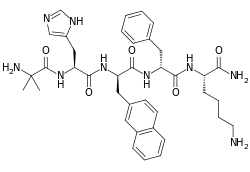Ipamorelin
Ipamorelin (INN) (developmental code name NNC 26-0161) is a peptide selective agonist of the ghrelin/growth hormone secretagogue receptor (GHS) and a growth hormone secretagogue.[2][3] It is a pentapeptide with the amino acid sequence Aib-His-D-2-Nal-D-Phe-Lys-NH2 that was derived from GHRP-1.[4]
 | |
| Clinical data | |
|---|---|
| Routes of administration | Intravenous, subcutaneous |
| ATC code |
|
| Pharmacokinetic data | |
| Elimination half-life | 2 hours[1] |
| Identifiers | |
IUPAC name
| |
| CAS Number | |
| PubChem CID | |
| ChemSpider | |
| UNII | |
| CompTox Dashboard (EPA) | |
| Chemical and physical data | |
| Formula | C38H49N9O5 |
| Molar mass | 711.85296 g/mol g·mol−1 |
| 3D model (JSmol) | |
SMILES
| |
InChI
| |
Ipamorelin significantly increases plasma growth hormone (GH) levels in both animals and humans.[1][3][5] In addition, ipamorelin stimulates body weight gain in animals.[5] Like pralmorelin and GHRP-6, ipamorelin does not affect prolactin, follicle-stimulating hormone (FSH), luteinizing hormone (LH), or thyroid-stimulating hormone (TSH) levels.[3] However, unlike pralmorelin (GHRP-2) and GHRP-6, but similarly to growth hormone-releasing hormone (GHRH), ipamorelin does not stimulate the secretion of adrenocorticotropic hormone (ACTH) or cortisol, and is highly selective for inducing the secretion only of GH.[3]
Ipamorelin was originally developed by Novo Nordisk, and was investigated in phase II clinical trials by Helsinn Therapeutics for the treatment of postoperative ileus, but was discontinued due to lack of efficacy.[6][7]
Ipamorelin has been used by athletes as a performance enhancing drug.[8][9][10]
See also
References
- Gobburu, Jogarao V. S.; Agersø, Henrik; Jusko, William J.; Ynddal, Lars (1999). "Pharmacokinetic-Pharmacodynamic Modeling of Ipamorelin, a Growth Hormone Releasing Peptide, in Human Volunteers". Pharmaceutical Research. 16 (9): 1412–1416. doi:10.1023/A:1018955126402. ISSN 0724-8741.
- Moulin, Aline; Ryan, Joanne; Martinez, Jean; Fehrentz, Jean-Alain (2007). "Recent Developments in Ghrelin Receptor Ligands". ChemMedChem. 2 (9): 1242–1259. doi:10.1002/cmdc.200700015. ISSN 1860-7179. PMID 17520591.
- Raun, K; Hansen, B.; Johansen, N.; Thogersen, H; Madsen, K; Ankersen, M; Andersen, P. (1998). "Ipamorelin, the first selective growth hormone secretagogue". European Journal of Endocrinology. 139 (5): 552–561. doi:10.1530/eje.0.1390552. ISSN 0804-4643.
- Isidro, Maria; Cordido, Fernando (2006). "Growth Hormone Secretagogues". Combinatorial Chemistry & High Throughput Screening. 9 (3): 175–180. doi:10.2174/138620706776055458. ISSN 1386-2073.
- Estrada, R. Cañete; Jiménez-Reina, L.; de la Torre, M.J.; Bernal, J. (2002). "Chronic In Vivo Ipamorelin Treatment Stimulates Body Weight Gain and Growth Hormone (GH) Release In Vitro in Young Female Rats". 6 (1): 37–46. ISSN 1136-4890. Cite journal requires
|journal=(help) - Beck, David E.; Sweeney, W. Brian; McCarter, Martin D. (2014). "Prospective, randomized, controlled, proof-of-concept study of the Ghrelin mimetic ipamorelin for the management of postoperative ileus in bowel resection patients". International Journal of Colorectal Disease. 29 (12): 1527–1534. doi:10.1007/s00384-014-2030-8. ISSN 0179-1958.
- AdisInsight. "Ipamorelin". Retrieved 10 June 2015.
- "Peptides under greater scrutiny in MLB's performance-enhancing drug battle". USA TODAY. Retrieved 2018-04-14.
- "NBA Playoffs 2018: Wizards' Jodie Meeks suspended 25 games for failing drug test". CBSSports.com. Retrieved 2018-04-14.
- "Nets' Chandler suspended 25 games for PED use". nba.com. Retrieved 2019-08-30.
External links